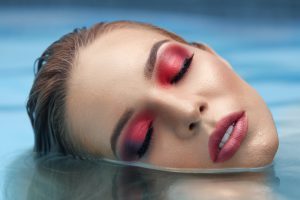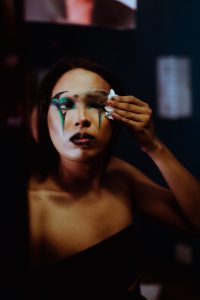All You Need To Know About Waterproof Makeup

You may start reaching for your waterproof makeup as the weather warms up and more opportunities to sweat (and swim) arise. But have you ever stopped to think about what, exactly, makes waterproof cosmetics…well, waterproof? We looked into it and found that some of the ingredients in your favorite formulas might surprise you.
Defining Waterproof Makeup
Waterproof makeup products are designed to resist moisture and stay in place, even when exposed to water. Waterproof formulas typically contain ingredients that give them adhesive qualities, so they stick to your skin, lashes, brows, etc.
Waterproof makeup can last through a few tears or beads of sweat, but if you’re planning on going for a swim, make sure to choose a waterproof option that won’t rub off.
What are Waterproof Makeups Made of?
To create products that resist water and stay glued in place, most companies who manufacture waterproof makeup use some or all of the following ingredients.
- Film Formers – The most commonly used waterproofing ingredient is the film former. This class of synthetic molecule includes polyvinylpyrrolidone (PVP), acrylates, acrylamides, silicones, and copolymers.
These chemicals work by creating a continuous barrier over the surface to which they are applied; this in turn safeguarding cosmetics from water damage.
- Silicones – Chemicals known as film formers are added to products to help water bead and roll off. Silicones, a type of film former, can be comedogenic (pore-clogging), cause breakouts, and are also skin sensitizers—irritating or even causing allergic reactions in some people.
- Polymers – Polymers protect surfaces by forming a barrier against water intrusion, and unlike film formers, they eventually evaporate.
Polymers are usually a safer waterproofing option than film formers, though most products that use polymers for waterproofing don’t actually work.
- Waxes – Plant-based waxes not only make products longer lasting, but they also do so without harsh chemicals that could potentially harm the skin or eyes. Forming a water-resistant barrier, plant waxes protect leaves in the same way they would products.
- Dimethicone – This harmful ingredient, dimethicone, is a silicone based polymer that companies add to their products in order to keep them from moving or disintegrating when exposed to water. However, what many don’t know is that it is considered a skin sensitizer with potential toxicity issues not just for our bodies but also the environment.
We obviously pay more for waterproof makeup because it is designed to last through any moisture, be it rain, sweat, or even tears.
Different Types of Waterproof Makeup
In the past, waterproof makeup products were only available for eyes. This was because there was a need for eye makeup that wouldn’t smear or run when wearing it during activities such as crying through a romance flick or spending a day out in the rain.
Nowadays, you can find any type of skincare product in a long-wearing waterproof formula.
Mascara
While waterproof makeup is the most popular type of cosmetic, it’s not necessarily the best for your eyelashes. In order to remove a waterproof mascara, you have to put in a lot more effort than with other formulas (which will be explained later). Also, wearing it on a daily basis can make your lashes brittle and weak which then leads to them breaking or falling out.
Eyeliner
Waterproof eyeliner can be helpful to prevent the darkness that can occur when your skin’s natural oils mix with regular eyeliner. However, waterproof liner is more dangerous for sensitive eyes, so extra care must be taken during application. Remember never to use it inside your lash line.
Brow Gel
Waterproof brow gel strengthens the formula with silicones to make it perform like hairspray. Tinted or clear, waterproof formulas can cause damage when removed .
Foundation
The only way to remove waterproof foundation is by using an oil-based cleanser; it’s a sticky product that adheres closely to the face. Most foundations of this type are occlusive, meaning they form a barrier on the skin that doesn’t allow moisture in.
Lipstick
Waterproof lipstick is designed to resist wear and tear, but it comes with a few trade-offs. In order to make the color last longer, manufacturers often have to infuse primer oils into the mix, which can ultimately affect the look of your lips if you prefer a glossier sheen.
Waterproof Products Explained
Before waterproofing your face with products that can withstand a tsunami, read this first.
Are you confused about whether waterproof or water-resistant makeup are different? Let’s break it down.
There is no difference between waterproof makeup and water-resistant makeup, technically speaking. Although, companies usually differentiate between waterproof and water-resistant to mean:
- waterproof makeup: will not come off when exposed to water, you can use it without worrying about damage.
- water-resistant makeup: Withstands common exposure to water, like rain or light swimming, however, it may smudge or fade when exposed to water for too long
Will Waterproof Makeup Withstand Sweat?
In short, yes. Your sweat may have salts or other chemicals that could possibly break down your makeup, but a waterproof product should contain a moisture-resistant barrier.
Is Waterproof Makeup Bad for My Pores?
The chemical ingredients in waterproof products that make them resistant to water are occlusive type compounds. This means that they create a barrier on your skin that doesn’t allow water through.
This might not guarantee that the ingredients will clog your pores but there’s undoubtedly a higher chance.
How frequently can I wear waterproof makeup without damaging my skin?
Although waterproof makeup does have its perks, keep in mind that it comes with certain risks. For example, if you constantly wear waterproof mascara, your lashes will become more brittle and susceptible to breakage. Unless your job is outdoors or You’re a professional swimmer, you probably don’t need infallible coverage.
It’s tough to remove waterproof formulas, and if you’re not careful while applying them, you could cause damage or irritation. So, save these products for special occasions like weddings or funerals.
How Can Waterproof Makeup be Removed?
Waterproof makeup can be a pain to remove, as these formulas tend to be quite sticky and difficult to budge. However, it’s important not to scrub at your skin too vigorously, as this will only cause irritation.
Instead, follow these steps for safe removal of waterproof makeup:
Oils
To remove almost all waterproof makeup formulas, you need an oil-based cleanser. Our favorite for removing makeup, especially difficult waterproof formulas, is Blood Orange Cleansing Balm.
Degreasing blood orange, plus coconut and olive oils can quickly and easily slide off your lashes, brows, and skin without causing irritation. In addition to cleansing your face, you’ll also be hydrating your skin with nourishing fatty acids.

If you don’t have time for a lengthy skincare routine or are on the go, using Makeup Removing Wipes is an effective way to remove your makeup and cleanse your skin. You can use them either dry or damp, and they’ll still work well.
Micellar Water
Micellar water is made with purified water, glycerin, and mild surfactants to help cleanse the skin. Micelles are small spheres created from this process that bond with dirt, oil, and makeup so it can be removed from the skin. While micellar water does work on some waterproof formulas, not all of them will be affected by it.
Balms
If you have dry skin, a skin balm can be more beneficial than other makeup removal methods because it includes waxes and oils that help to breakdown waterproof formulas while also moisturizing your skin.
Milks
Although cleansing milks don’t actually contain milk, they are called so because of their light texture and color. standard cleansers often include harsh ingredients such as sulfates and chemicals that can cause skin irritation; whereas, cleansing milks usually consist of gentler ingredients.
Cleansing milks are typically created with a mix of oils and emollients which should be successful in removing waterproof makeup products. If your waterproof makeup is giving you trouble though, it could be because the ratio between oil and other components in the formula doesn’t match up.
Bottom line
While waterproof makeup is great for those occasions when you need it, most days you don’t need such a harsh product. Waterproof makeup contains ingredients that can be dangerous for your skin, so it’s not something you want to use every day. Stick to cleaner, greener products that are just as long-lasting and you’ll be happier with the results.




